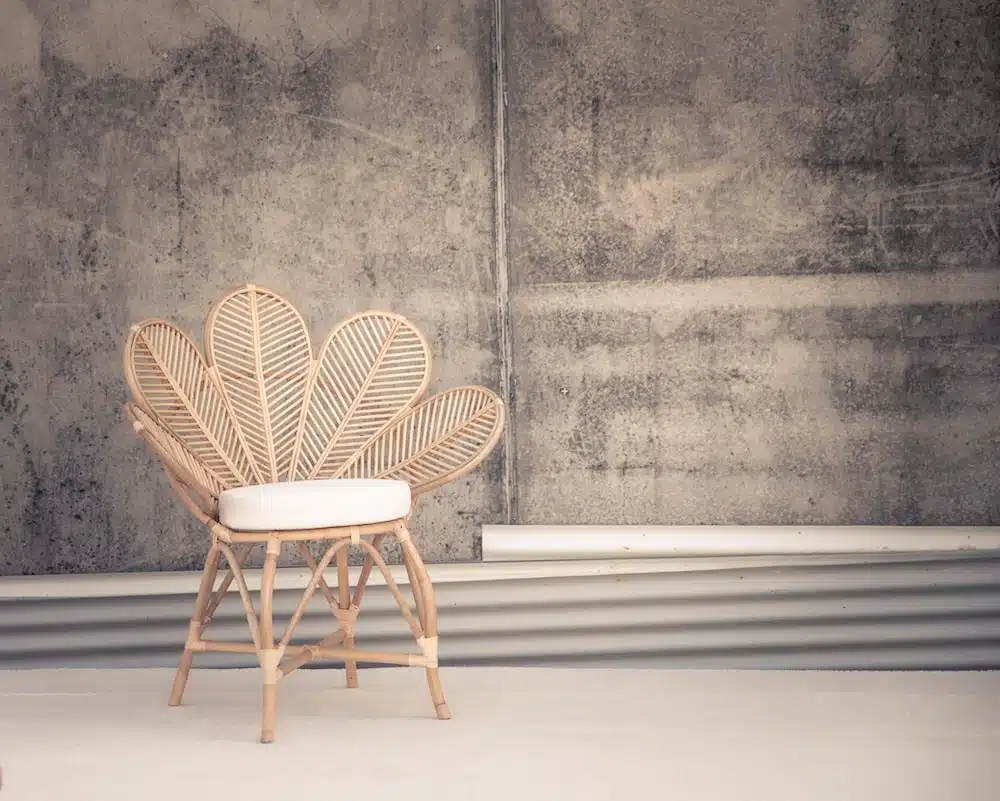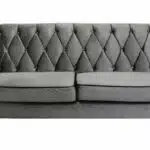Rattan furniture is a popular choice for people who want to add a touch of natural charm to their homes. The material is lightweight, durable, and versatile enough to fit into any interior design style. However, like any other furniture, rattan pieces need regular cleaning to maintain their beauty and longevity. This article aims to provide you with expert tips on how to clean rattan furniture effectively.
As an experienced rattan furniture cleaning expert, I have seen countless homeowners struggle with maintaining the cleanliness of their rattan pieces. Many people make the mistake of using harsh chemicals or abrasive tools that can damage the furniture’s delicate surface. In this article, I will share my knowledge on the best practices for cleaning rattan furniture without causing any harm to its natural fibers and finish. Whether you own a set of chairs or a large daybed, these tips will help you keep your rattan furniture looking as good as new for years to come.
Understanding Rattan Furniture
Despite its popularity, cleaning rattan furniture can be a daunting task for many. However, with the right tools and techniques, keeping your rattan furniture looking its best is relatively easy. As an expert in rattan furniture cleaning, I understand that people might be hesitant to clean their rattan furniture due to concerns about damaging it. But fear not! With proper care and maintenance, your rattan furniture can last for years.
One of the benefits of rattan furniture is that it is lightweight and durable. Rattan is a natural material that grows in tropical regions and is known for its resilience. It can withstand exposure to sunlight and moisture, making it an ideal choice for outdoor furniture. Different types of rattan weaves are available in the market, including wicker, cane, and bamboo. Each type has distinct characteristics that make it unique.
Wicker is one of the most popular types of rattan weave used in furniture making. It has a simple yet elegant design that complements any decor style. Cane weave is similar to wicker but has a tighter weave pattern and provides more support when used as seating or backing material. Bamboo weave is another popular type of rattan weave used in furniture making. It has a smooth finish and adds a touch of sophistication to any space. Understanding these different types of weaves will help you choose the right cleaning method for your specific piece of rattan furniture. To begin preparing your workspace…
Preparing Your Workspace
After understanding the basics of rattan furniture, it is time to move onto the next crucial step – preparing your workspace. Before you start cleaning, make sure you have a designated area that is spacious enough for you to move around and maneuver the furniture. It is also recommended to work outside or in a well-ventilated room as cleaning solutions can emit strong fumes.
Organizing your workspace is essential to ensure an efficient and safe cleaning process. Begin by clearing any clutter around the furniture and creating a checklist of all the tools you’ll need for the job. This includes soft-bristled brushes, microfiber cloths, mild soap, water, and protective gloves. It’s important to take safety precautions seriously when handling cleaning products and wear gloves to protect your skin.
Ventilation requirements are another important aspect of setting up your workspace. Ensure that there is enough fresh air circulating in the area by opening windows or doors. If you’re working indoors, consider using a fan or air purifier to improve air quality. These measures will help prevent any respiratory issues that could arise from inhaling chemical fumes during the cleaning process.
As you prepare your workspace for cleaning rattan furniture, it’s crucial to remember the importance of protective measures, safety precautions and ventilation requirements. Organize your tools effectively and ensure there is enough space for you to work comfortably while avoiding unnecessary accidents. By taking these steps seriously, you can guarantee a successful outcome when it comes to restoring your rattan furniture’s shine and beauty in no time! Next up – gathering the right supplies for a thorough clean!
Gathering The Right Supplies
To effectively clean rattan furniture, you need to have the right supplies. Choosing the appropriate cleaning solutions and tools is essential in ensuring that your rattan furniture remains spotless and in mint condition. The best cleaning solutions for rattan furniture include mild soap, vinegar, and warm water. These are gentle yet effective solutions that can remove dirt and grime without damaging the natural fibers of your rattan furniture.
When it comes to choosing the best cleaning tools for your rattan furniture, consider investing in a soft-bristled brush or a microfiber cloth. These tools will not scratch or damage the delicate fibers of your rattan furniture while removing dirt and debris. A soft-bristled brush is perfect for reaching those hard-to-reach areas such as crevices and corners.
The key to maintaining the integrity of your rattan furniture is by using a combination of gentle cleaning solutions and appropriate tools. By doing so, you can keep your rattan furniture looking great for years to come. In the subsequent section, we will discuss how to remove loose dirt and debris from your rattan furniture before proceeding with deeper cleaning methods.
Removing Loose Dirt And Debris
- Sweeping is an effective method for removing visible dirt and debris from the surface of rattan furniture.
- Vacuuming is recommended for removing hidden dirt and debris from rattan furniture.
- Damp cloths may be used to gently wipe away any remaining particles from the furniture’s surface.
- An appropriate vacuum attachment should be used to ensure that the rattan is not damaged while vacuuming.
- Cloths should be dampened with warm water mixed with a mild soap to ensure that the furniture is not damaged while being wiped.
- Care should be taken to ensure that rattan furniture is not exposed to excess moisture while cleaning.
Sweeping
Rattan furniture is a beautiful addition to any home, but it can be a challenge to keep clean. One of the most important steps in cleaning rattan furniture is removing loose dirt and debris. Sweeping is an effective method for achieving this task.
Proper sweeping techniques are essential when cleaning rattan furniture. It is important to use a soft-bristled brush or a vacuum with a soft brush attachment to avoid damaging the delicate material. When sweeping, start from the top and work your way down, using gentle strokes to remove dirt and dust.
Sweeping and vacuuming both have their pros and cons when it comes to cleaning rattan furniture. While sweeping can be gentler on the material, vacuuming may be more efficient at removing smaller particles. Ultimately, the best method will depend on the specific type of rattan furniture being cleaned, as well as personal preference.
Remember that removing loose dirt and debris is just one step in keeping your rattan furniture looking its best. Regular maintenance is key to ensuring its longevity and beauty. By following proper sweeping techniques and choosing the right tools for the job, you can enjoy your rattan furniture for years to come.
Vacuuming
Removing loose dirt and debris is an essential step in cleaning rattan furniture. As a rattan furniture cleaning expert, I recommend using proper sweeping techniques to achieve this task. Sweeping with a soft-bristled brush or a vacuum with a soft brush attachment can effectively remove dirt and dust without damaging the delicate material.
While sweeping may be gentler on rattan furniture, vacuuming has its benefits when it comes to removing smaller particles. Choosing the right vacuum for the job is crucial in ensuring that your rattan furniture stays clean and undamaged. A vacuum with adjustable suction power and a soft brush attachment can efficiently remove debris from intricate areas of the furniture.
In conclusion, both sweeping and vacuuming are effective methods for removing loose dirt and debris from rattan furniture. The choice between the two will depend on personal preference and the specific type of rattan furniture being cleaned. By choosing the right tool for the job and following proper techniques, you can ensure that your rattan furniture stays beautiful for years to come.
Damp Cloths
Another effective method for removing loose dirt and debris from rattan furniture is through the use of damp cloths. Damp cloths can effectively pick up dirt, dust, and other particles without damaging the delicate material. As a rattan furniture cleaning expert, I recommend using a mixture of water and vinegar to dampen the cloth. This solution is gentle enough to avoid causing water damage to the rattan while still being effective in cleaning.
When using damp cloths, it’s essential to avoid soaking the rattan with too much water. Excess moisture can cause warping or discoloration of the material. Instead, lightly dampen the cloth with the vinegar and water solution before gently wiping down the furniture’s surface. Pay extra attention to hard-to-reach areas where dirt and debris may have accumulated.
Incorporating damp cloths into your rattan furniture cleaning routine can help keep your furniture looking beautiful for years to come. When done correctly, this method can effectively remove loose dirt and debris without causing any damage or water stains on your precious pieces. Remember always to be gentle when cleaning your rattan furniture as it is a delicate material that requires special care.
Vacuuming The Surface
After removing the loose dirt and debris from your rattan furniture, it is important to thoroughly clean the surface of the furniture. A common misconception is that rattan furniture should only be cleaned with water, but this can actually cause damage to the material. The best way to clean rattan furniture is by using a soft-bristled brush and a mild cleaning solution.
Using a brush, gently scrub the surface of the furniture in circular motions. Be sure not to apply too much pressure as this can cause damage to the material. Once you have thoroughly scrubbed the surface, rinse off any remaining cleaning solution with a damp cloth. Allow the furniture to dry completely before moving on to the next step.
Steam cleaning is another effective method for cleaning rattan furniture. This method uses high-pressure steam to remove dirt and stains from deep within the fibers of the material. However, it is important to note that steam cleaning should only be done by a professional as improper use can cause damage to your furniture.
Now that you have thoroughly cleaned your rattan furniture, it’s time to move on to treating any stains or spills that may have occurred. Whether it’s wine spills or ink marks, there are certain steps you can take to effectively remove these stubborn stains without causing damage to your beautiful piece of furniture.
Treating Stains And Spills
Removing stains from rattan furniture can be a challenge, but with the right techniques, it is possible to get rid of stubborn marks. One way to do this is by using a mixture of mild soap and water. Simply mix some mild soap with warm water and dip a soft cloth into the solution. Gently rub the stained area until the stain disappears. Be sure to use only a small amount of water to avoid saturating the rattan.
Another method for removing stains from rattan furniture involves using vinegar. Mix equal parts white vinegar and warm water in a spray bottle and apply it directly to the stained area. Allow the solution to sit for a few minutes before wiping it off with a clean, dry cloth. This method works well for stubborn stains that are difficult to remove with just soap and water.
To prevent future spills from staining your rattan furniture, there are several steps you can take. First, try to avoid placing drinks or food on your rattan furniture without using coasters or placemats. Additionally, consider applying a protective coating to your furniture such as wax or sealant. These coatings will help repel liquids and prevent them from penetrating deep into the rattan fibers.
Transitioning into the subsequent section about avoiding harsh chemicals, it’s important not to use strong cleaning agents when treating stains on rattan furniture. While these may seem like an easy solution, they can actually damage the natural fibers of your furniture over time. Instead, opt for gentler cleaning solutions that are specifically designed for use on delicate materials like rattan. In the next section, we’ll discuss some effective ways to clean your rattan furniture without resorting to harsh chemicals that could potentially harm its integrity over time.
Avoiding Harsh Chemicals
Cleaning rattan furniture is like taking care of a delicate plant that needs proper nurturing. If you use harsh chemicals, it can damage the natural fibers and leave the furniture looking dull and lifeless. Eco-friendly alternatives are gaining traction as people realize the hazards of using chemical cleaners. Fortunately, there are gentle cleaning methods that can help keep your rattan furniture looking its best without damaging it.
One eco-friendly alternative to harsh chemicals is white vinegar, which can be used in combination with water to remove dirt and grime from your rattan furniture. Mix equal parts of white vinegar and water in a spray bottle and apply it to the surface of your furniture. Gently scrub with a soft-bristled brush or cloth, then rinse thoroughly with water.
Another gentle cleaning method is using mild dish soap mixed with warm water. This solution can be applied in the same way as the white vinegar mixture for effective yet gentle cleaning. Be sure to avoid soaking your rattan furniture in water as this can cause swelling or warping of the fibers. Instead, use a damp cloth to wipe down surfaces and dry them immediately afterward.
Using natural cleaners is not only good for your rattan furniture but also for the environment. By avoiding harsh chemicals, we reduce our impact on nature while keeping our homes clean and tidy. In the next section, we will explore some natural cleaners that are safe for both you and your rattan furniture.
Using Natural Cleaners
Now that we know the importance of avoiding harsh chemicals when cleaning rattan furniture, let’s explore some eco-friendly alternatives. DIY natural cleaners are a great option for those who want to keep their homes clean and healthy without harming the environment. With just a few simple ingredients, you can create effective cleaning solutions that won’t damage your rattan furniture.
One popular natural cleaner is white vinegar. This versatile ingredient can be used to clean everything from floors to windows, and it’s also great for removing stains from rattan furniture. Simply mix equal parts white vinegar and water in a spray bottle, then spritz the solution onto your rattan furniture and wipe it down with a soft cloth. For tougher stains, you can add a bit of baking soda to the mixture to create a gentle abrasive.
Another eco-friendly option is olive oil. Not only does this kitchen staple make a delicious salad dressing, but it can also be used to protect and nourish your rattan furniture. To apply oil to your rattan pieces, simply dip a soft cloth into some olive oil and rub it gently onto the surface of the furniture. This will help to prevent cracking and keep your rattan looking beautiful for years to come.
When it comes to keeping your rattan furniture clean and well-maintained, there are plenty of natural options available. By using DIY natural cleaners like white vinegar and olive oil, you can avoid harsh chemicals while still achieving excellent results. In the next section, we’ll discuss how to apply wax or oil to your rattan furniture for even greater protection and longevity.
Applying Wax Or Oil
Identifying the right wax or oil for rattan furniture is an important step in the cleaning process. The type of wax or oil used should be selected based on the type of rattan, the condition of the furniture, and the desired level of protection and shine. Cleaning the rattan before applying wax or oil is essential in order to achieve a smooth and even finish. All dirt and dust should be removed with a gentle cleaning solution and a soft cloth. Applying wax or oil properly is key to preserving the rattan furniture’s natural beauty. A thin and even layer should be applied with a soft cloth, buffing the wax or oil in a circular motion. Finally, it is important to allow the wax or oil to dry completely before use.
Identifying The Right Wax Or Oil
When it comes to cleaning rattan furniture, using the right wax or oil can make all the difference in maintaining its shine and longevity. Choosing between wax and oil depends on personal preference and the specific needs of the rattan piece. While both options provide protection against moisture, UV rays, and scratches, each has distinct benefits.
Natural wax is a popular choice for those who prefer a more traditional finish. It creates a protective layer on the surface of the rattan while enhancing its natural beauty. Natural wax also helps to repel water, preventing mold and mildew growth. Additionally, it provides an extra layer of protection against scratches and fading due to UV rays. Overall, natural wax is a great option for those who want to maintain the authentic look of their rattan furniture.
On the other hand, natural oil is an excellent option for those who prefer a more modern finish. It penetrates deep into the rattan fibers, creating a durable barrier that protects against moisture damage while enriching its color. Natural oils are also eco-friendly and non-toxic, making them ideal for families with children or pets. Using natural oil regularly can help keep your rattan furniture looking new for years to come.
In conclusion, choosing between wax and oil ultimately boils down to personal preference and the specific needs of your rattan furniture. Both options provide exceptional benefits when used correctly, so it’s essential to choose one that aligns with your style and maintenance goals. Whether you opt for natural wax or oil, regular application will keep your rattan pieces looking beautiful for years to come.
Cleaning The Rattan Before Applying Wax Or Oil
Before applying wax or oil to your rattan furniture, it’s crucial to ensure that the surface is clean and free of any dirt or debris. Pre cleaning techniques are essential in preserving the natural beauty of rattan while preventing damage caused by harsh chemicals. One effective pre-cleaning technique is to use a soft-bristled brush to remove any loose particles from the surface. After pre-cleaning your rattan furniture, the next step is selecting cleaning products that are safe and gentle on the material. Avoid using abrasive cleaners, bleach, or ammonia-based products as these can cause discoloration and weaken the structure of rattan. Instead, opt for mild soap and warm water solution applied with a soft cloth or sponge. Always test any cleaning product on an inconspicuous area before applying it to the entire piece. By following proper pre-cleaning techniques and selecting gentle cleaning products, you can ensure that your rattan furniture remains beautiful and durable for years to come. Taking these steps before applying wax or oil will help to enhance their protective properties while maintaining its natural look and feel. As a rattan furniture cleaning expert, I highly recommend incorporating these steps into your routine maintenance for optimal results.
Applying Wax Or Oil Properly
After pre-cleaning and selecting gentle cleaning products, the next step in maintaining your rattan furniture is applying wax or oil properly. When it comes to applying wax, it’s important to use a product specifically designed for use on natural fibers like rattan. Beeswax or carnauba wax are two popular options that provide excellent protection against moisture and wear. The frequency of application depends on how often the furniture is used and exposed to elements like sunlight and humidity. As a general rule, it’s recommended to apply wax every six months to maintain its protective properties.
On the other hand, applying oil to rattan furniture can provide numerous benefits such as preventing cracking or splitting due to dryness while enhancing its natural shine. However, there are potential drawbacks such as attracting dust or dirt over time and potentially causing discoloration if not applied correctly. It’s important to choose a high-quality oil product that is specifically formulated for use on rattan and follow the manufacturer’s instructions carefully. The frequency of application can vary depending on factors like usage and environmental conditions but generally should be done every 12-18 months.
Overall, applying wax or oil properly is a crucial part of maintaining the beauty and durability of your rattan furniture. Knowing which type of product to use and how often to apply it can help prevent damage from harsh environmental factors while preserving its natural look and feel. As a rattan furniture cleaning expert, I highly recommend incorporating these steps into your routine maintenance for optimal results that will last for years to come.
Maintaining The Surface
As a rattan furniture cleaning expert, I can tell you that maintaining the surface of your furniture is just as important as cleaning it. You’ll want to keep the surface in top condition to prevent discoloration, damage, and other issues that could arise from neglecting it.
One way to maintain the surface of your rattan furniture is by applying protective coatings. These coatings can help protect your furniture from scratches, stains, and other damage that could occur during everyday use. There are many different types of protective coatings available on the market today, so be sure to do your research and choose one that suits your needs.
Another way to maintain the surface of your rattan furniture is by preventing discoloration. This can be done by keeping your furniture out of direct sunlight and away from heat sources. You may also want to consider using a UV-resistant spray or cover to protect it from harmful UV rays. With proper care and maintenance, you can keep your rattan furniture looking beautiful for years to come.
To continue taking care of your rattan furniture, the next step is storing it properly when not in use.
Storing Rattan Furniture
To maintain the surface of your rattan furniture, it is important to keep it clean and free from dust and debris. However, proper cleaning techniques are crucial in order to avoid causing damage or discoloration. One effective method is to use a soft-bristled brush or vacuum cleaner attachment to remove any loose dirt or dust particles.
In addition to regular cleaning, storing your rattan furniture properly can also help prolong its lifespan. There are various storage solutions available depending on the size and shape of your pieces. For example, you can use protective covers or tarpaulins to shield them from moisture and harsh weather conditions during the winter season. Alternatively, you can store them in a dry area indoors such as a garage or basement.
By taking these precautions, you can prevent your rattan furniture from becoming damaged or discolored over time. This will not only save you money on repairs or replacements but also ensure that your pieces remain beautiful and functional for years to come. In the next section, we will discuss how to clean outdoor rattan pieces using specific techniques and products designed for this purpose.
Cleaning Outdoor Rattan Pieces
Did you know that outdoor rattan furniture is becoming increasingly popular among homeowners? In fact, sales of outdoor rattan pieces have risen by 20% in the past year alone. While this type of furniture can add a stylish touch to any backyard, it also requires proper maintenance to ensure its longevity.
Choosing the right cleaner for your outdoor rattan pieces is crucial. Harsh chemicals and abrasive cleaning tools can damage the delicate fibers of the rattan and cause it to weaken over time. Instead, opt for a gentle cleaner specifically designed for wicker or rattan furniture. You can also make your own cleaning solution using warm water and mild dish soap. Be sure to test any cleaning product on a small, inconspicuous area before applying it to the entire piece.
Preventing future damage is just as important as cleaning your outdoor rattan pieces properly. Avoid exposing them to direct sunlight or extreme temperatures for extended periods of time. Use cushions or covers when not in use to protect them from the elements. Regularly dusting and wiping down your rattan furniture will also prevent dirt and debris from accumulating, which can lead to discoloration and damage over time.
Now that you know how to properly clean and maintain your outdoor rattan pieces, what do you do if they are already damaged? In the next section, we will discuss how to restore damaged rattan furniture without having to replace it entirely.
Restoring Damaged Rattan Furniture
Cleaning outdoor rattan furniture is an essential task that must be done regularly to keep it in good condition. However, sometimes accidents happen, and your rattan furniture may get damaged. Fortunately, there are DIY restoration techniques that you can use to bring your damaged rattan furniture back to life.
Firstly, before attempting any repairs on your rattan furniture, make sure that it is clean and dry. You can use a soft-bristled brush or a vacuum cleaner to remove any dust or debris from the surface of the furniture. Once the surface is clean, you can begin repairing any damage using DIY techniques such as wrapping broken pieces with twine or reweaving missing sections.
Secondly, if there are any loose strands on the surface of the rattan, you can use a pair of scissors to trim them carefully. Be careful not to cut too much material as this may cause more damage. Additionally, you can apply a coat of clear lacquer on the repaired section to protect it from moisture and further damage.
Finally, if you are not confident in repairing your rattan furniture yourself, it is always best to consult with a professional. They have the expertise and tools needed to restore your rattan furniture properly without causing further damage. By following these tips and consulting with professionals when necessary, you can keep your rattan furniture looking great for years to come.
Here are some additional tips for restoring damaged rattan furniture:
If there are cracks in the wood part of your rattan furniture, fill them with wood filler before starting any repairs.
To prevent future damage from exposure to sunlight and moisture, consider using a cover or storing your outdoor rattan pieces indoors during harsh weather conditions.
For stubborn stains on the surface of your rattan furniture that cannot be removed through regular cleaning methods, try using vinegar mixed with warm water as a natural cleaning solution.
Remember that restoring damaged rattan furniture can be a challenging task, but with the right techniques and tools, it is possible to bring your pieces back to life. By following these tips and consulting with professionals when necessary, you can keep your rattan furniture looking great for years to come.
Consulting With A Professional
When it comes to cleaning rattan furniture, you may find yourself overwhelmed and unsure of where to start. While there are plenty of DIY methods available online, sometimes it’s best to consult with a professional. By doing so, you can ensure that your rattan furniture is properly cared for and maintained.
One of the benefits of consulting with a professional is that they have experience working specifically with rattan furniture. They know the ins and outs of what works best for cleaning and maintaining this type of material. Additionally, they can provide personalized advice based on the condition and age of your specific piece(s) of furniture.
However, there are also some drawbacks to consider when consulting with a professional. This option may be more expensive than attempting to clean the furniture yourself, especially if you have multiple pieces that need attention. Additionally, not all professionals may use eco-friendly or non-toxic products which could be harmful to both your furniture and the environment.
Overall, consulting with a professional can be a great option for those who want their rattan furniture cleaned properly without any guesswork involved. It’s important to weigh both the benefits and drawbacks before deciding which cleaning method is right for you and your unique situation. In the next section, we’ll discuss how to keep your rattan furniture in top condition after it’s been cleaned.
Conclusion: Keeping Your Rattan Furniture In Top Condition
Consulting with a Professional has provided you with valuable insights on how to properly clean your rattan furniture. Now that you know the basics, it’s time to learn more about how to keep your furniture in its best condition for long-term use.
To protect your rattan furniture from dirt and damage, consider investing in protective covers. These covers can help shield your furniture from harsh weather conditions, as well as prevent scratches and stains caused by accidental spills. It is important to choose covers made of breathable materials such as cotton or canvas to allow air circulation and prevent mold growth.
Proper seasonal maintenance is also essential in keeping your rattan furniture looking its best. During summer months, inspect your furniture regularly for signs of wear and tear, and remove any debris using a soft brush or vacuum cleaner. In winter, store your rattan furniture indoors or in a dry area with low humidity levels to prevent cracking and damage caused by moisture.
Sub-list 1:
- Use cleaning solutions specifically designed for rattan furniture
- Avoid using abrasive cleaners or harsh chemicals that can cause discoloration and damage
Sub-list 2:
- Regularly dust or vacuum cushions and upholstery
- Clean spills immediately using a damp cloth and mild detergent solution
As an expert in rattan furniture cleaning, I highly recommend following these tips to keep your investment looking new for years to come. With proper care and maintenance, you can enjoy the beauty of your rattan furniture while protecting it from unnecessary wear and tear. Remember: preventative measures are key!
Conclusion
In conclusion, the process of cleaning rattan furniture is not as daunting as it may seem. With the right tools and techniques, you can keep your pieces looking their best for years to come. Remember to start by understanding the nature of your rattan furniture and preparing your workspace accordingly.
Invest in quality cleaning supplies and take care when removing loose dirt and debris. Vacuuming the surface will help eliminate any hidden particles that might cause damage over time. For outdoor furniture, consider using a power washer or specialized cleaner to get rid of tough stains.
If you have damaged or worn-out rattan furniture, don’t despair. There are restoration services available that can help bring new life to your cherished pieces. And if all else fails, consult with a professional who can offer expert advice on how to clean and maintain your rattan furniture.
In short, by taking the time to properly care for your rattan furniture, you can ensure that it remains strong, beautiful, and functional for many years to come. So don’t hesitate – start cleaning today!
Image Credits
- “white and brown wooden chair” by Jesse Donoghoe (featured)






![How To Clean A Wax Warmer 6 [1425] Wax Moth (Galleria mellonella)](https://green-life.blog/wp-content/uploads/2023/05/TlTgCqusrajq-150x150.jpg.webp)






















